warning YAMAHA WR 450F 2006 User Guide
[x] Cancel search | Manufacturer: YAMAHA, Model Year: 2006, Model line: WR 450F, Model: YAMAHA WR 450F 2006Pages: 786, PDF Size: 22.49 MB
Page 222 of 786

3 - 14
INSP
ADJ
ENGINE OIL LEVEL INSPECTION
ENGINE OIL LEVEL INSPECTION
1. Stand the machine on a level surface.
NOTE:
When checking the oil level make sure that
the machine is upright.
Place the machine on a suitable stand.
WARNING
Never remove the oil tank cap just after
high speed operation. The heated oil could
spurt out. causing danger. Wait until the oil
cools down to approximately 70 °C (158 °F).
2. Idle the engine more than 3 minutes while
keeping the machine upright. Then stop the
engine and inspect the oil level.
3. Remove:
Oil tank cap 1
1
4. Inspect:
Oil level
Oil level should be between maximum a
and minimum b marks.
Oil level low → Add oil to proper level.
NOTE:
When inspecting the oil level, do not screw the
oil level gauge into the oil tank.
Insert the gauge lightly.
a
b
Page 244 of 786
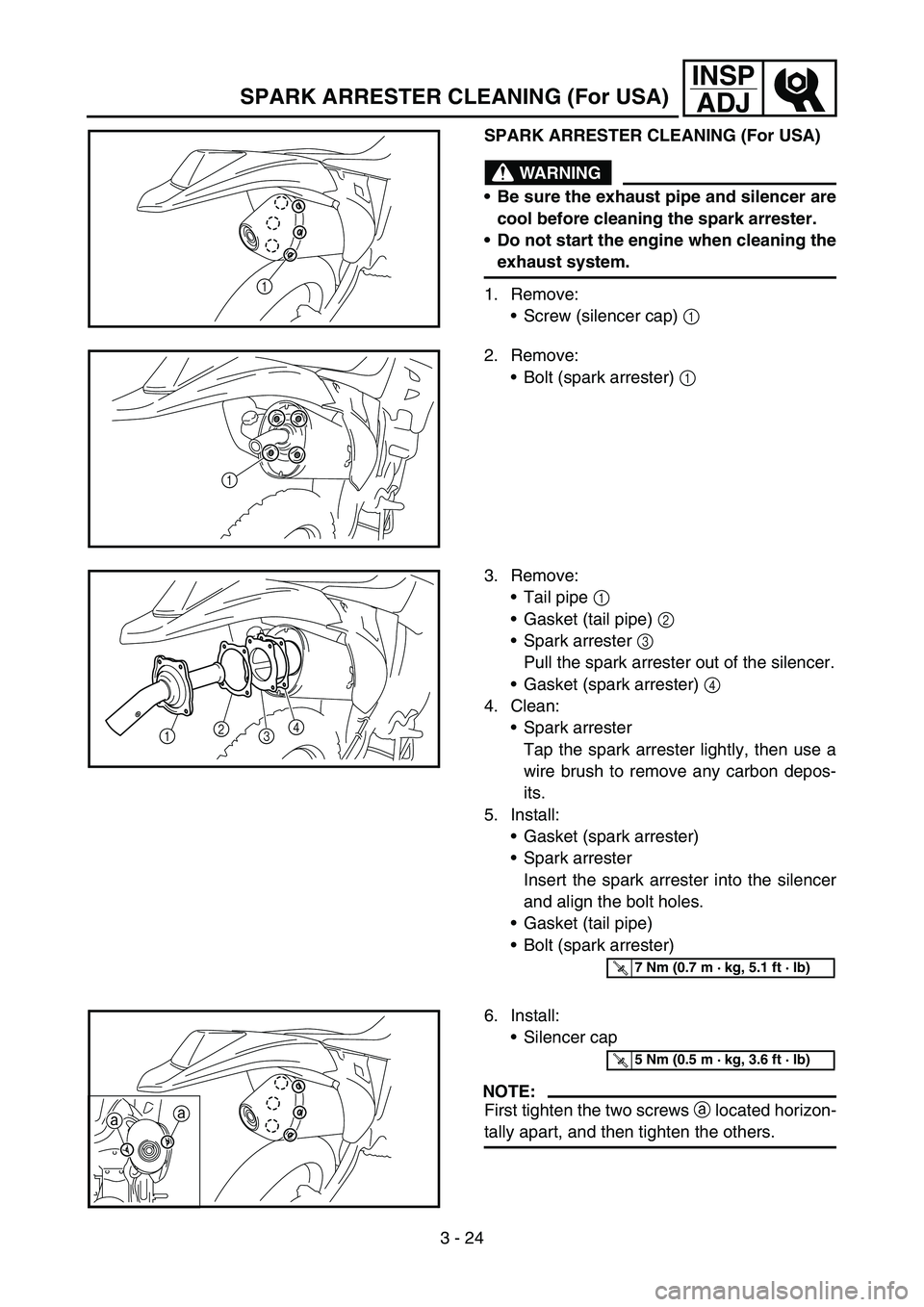
3 - 24
INSP
ADJ
SPARK ARRESTER CLEANING (For USA)
WARNING
Be sure the exhaust pipe and silencer are
cool before cleaning the spark arrester.
Do not start the engine when cleaning the
exhaust system.
1. Remove:
Screw (silencer cap) 1
1
2. Remove:
Bolt (spark arrester) 1
1
3. Remove:
Tail pipe 1
Gasket (tail pipe) 2
Spark arrester 3
Pull the spark arrester out of the silencer.
Gasket (spark arrester) 4
4. Clean:
Spark arrester
Tap the spark arrester lightly, then use a
wire brush to remove any carbon depos-
its.
5. Install:
Gasket (spark arrester)
Spark arrester
Insert the spark arrester into the silencer
and align the bolt holes.
Gasket (tail pipe)
Bolt (spark arrester)
12
34
T R..7 Nm (0.7 m · kg, 5.1 ft · lb)
6. Install:
Silencer cap
NOTE:
First tighten the two screws a located horizon-
tally apart, and then tighten the others.aa
T R..5 Nm (0.5 m · kg, 3.6 ft · lb)
SPARK ARRESTER CLEANING (For USA)
Page 246 of 786
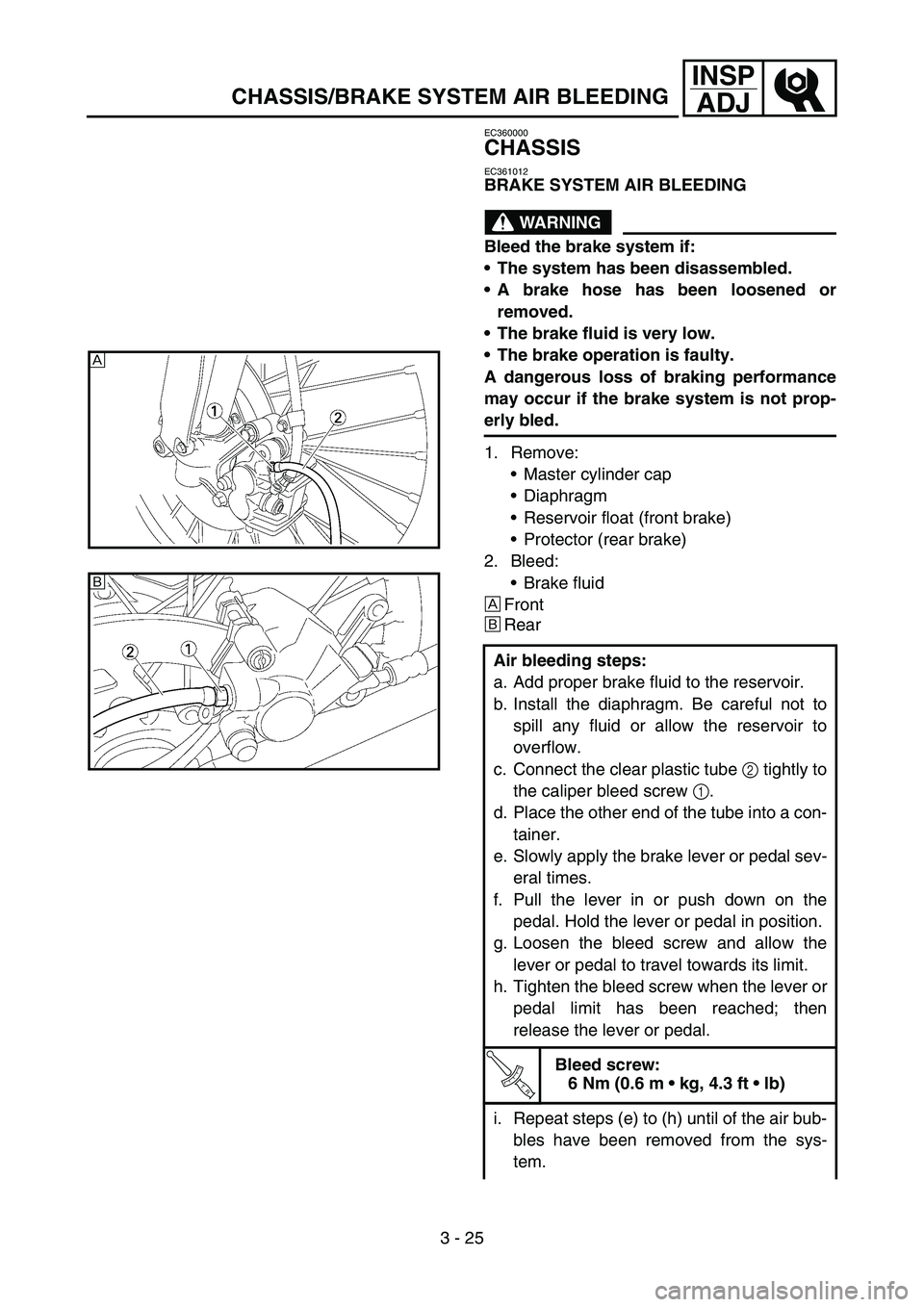
3 - 25
INSP
ADJ
CHASSIS/BRAKE SYSTEM AIR BLEEDING
EC360000
CHASSIS
EC361012
BRAKE SYSTEM AIR BLEEDING
WARNING
Bleed the brake system if:
The system has been disassembled.
A brake hose has been loosened or
removed.
The brake fluid is very low.
The brake operation is faulty.
A dangerous loss of braking performance
may occur if the brake system is not prop-
erly bled.
1. Remove:
Master cylinder cap
Diaphragm
Reservoir float (front brake)
Protector (rear brake)
2. Bleed:
Brake fluid
ÈFront
ÉRear
Air bleeding steps:
a. Add proper brake fluid to the reservoir.
b. Install the diaphragm. Be careful not to
spill any fluid or allow the reservoir to
overflow.
c. Connect the clear plastic tube 2 tightly to
the caliper bleed screw 1.
d. Place the other end of the tube into a con-
tainer.
e. Slowly apply the brake lever or pedal sev-
eral times.
f. Pull the lever in or push down on the
pedal. Hold the lever or pedal in position.
g. Loosen the bleed screw and allow the
lever or pedal to travel towards its limit.
h. Tighten the bleed screw when the lever or
pedal limit has been reached; then
release the lever or pedal.
T R..
Bleed screw:
6 Nm (0.6 m kg, 4.3 ft lb)
i. Repeat steps (e) to (h) until of the air bub-
bles have been removed from the sys-
tem.
È
É
Page 248 of 786
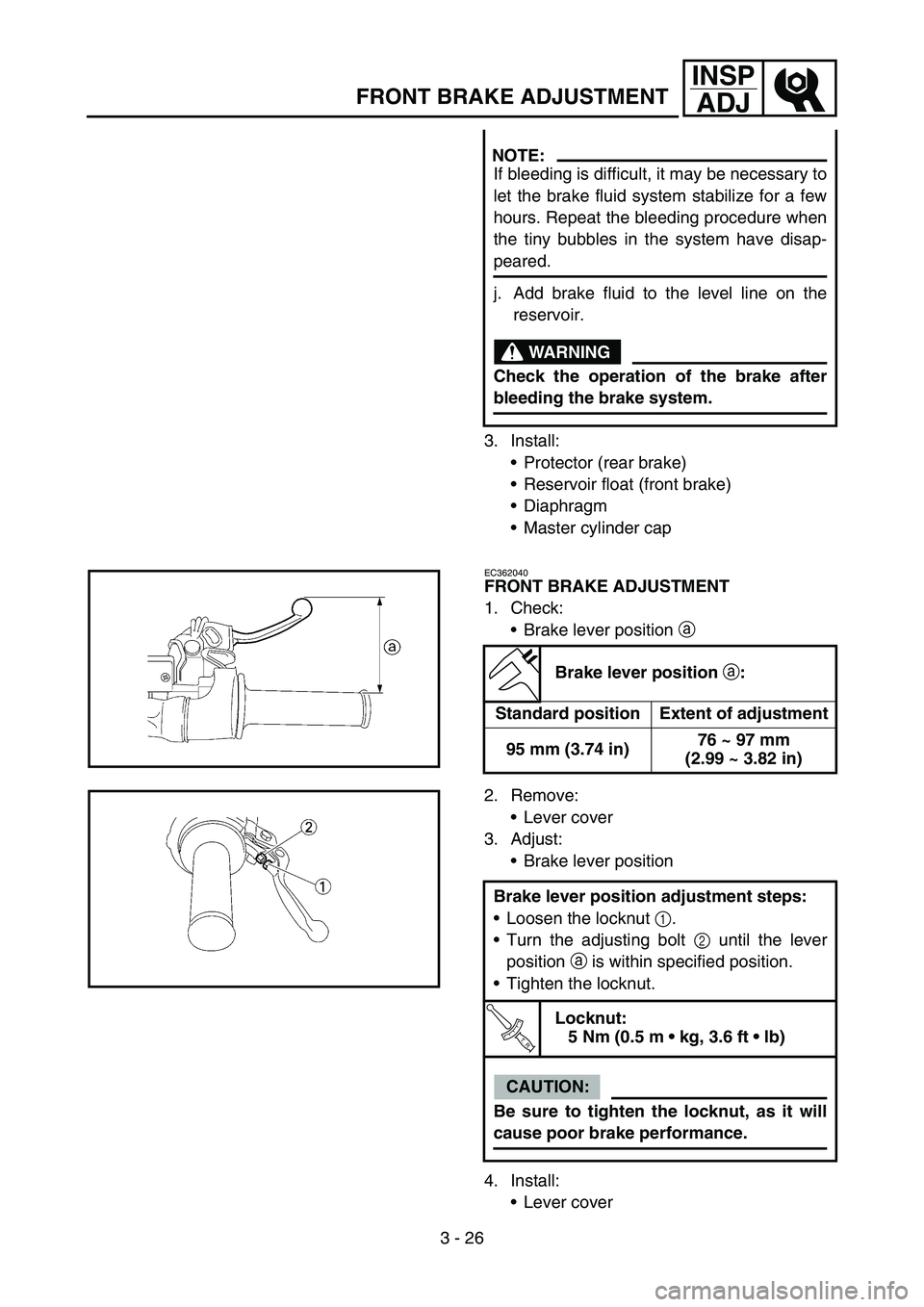
3 - 26
INSP
ADJ
FRONT BRAKE ADJUSTMENT
3. Install:
Protector (rear brake)
Reservoir float (front brake)
Diaphragm
Master cylinder cap
NOTE:
If bleeding is difficult, it may be necessary to
let the brake fluid system stabilize for a few
hours. Repeat the bleeding procedure when
the tiny bubbles in the system have disap-
peared.
j. Add brake fluid to the level line on the
reservoir.
WARNING
Check the operation of the brake after
bleeding the brake system.
EC362040
FRONT BRAKE ADJUSTMENT
1. Check:
Brake lever position a
Brake lever position
a:
Standard position Extent of adjustment
95 mm (3.74 in)76 ~ 97 mm
(2.99 ~ 3.82 in)
2. Remove:
Lever cover
3. Adjust:
Brake lever position
4. Install:
Lever cover Brake lever position adjustment steps:
Loosen the locknut 1.
Turn the adjusting bolt 2 until the lever
position a is within specified position.
Tighten the locknut.
T R..
Locknut:
5 Nm (0.5 m kg, 3.6 ft lb)
CAUTION:
Be sure to tighten the locknut, as it will
cause poor brake performance.
Page 250 of 786
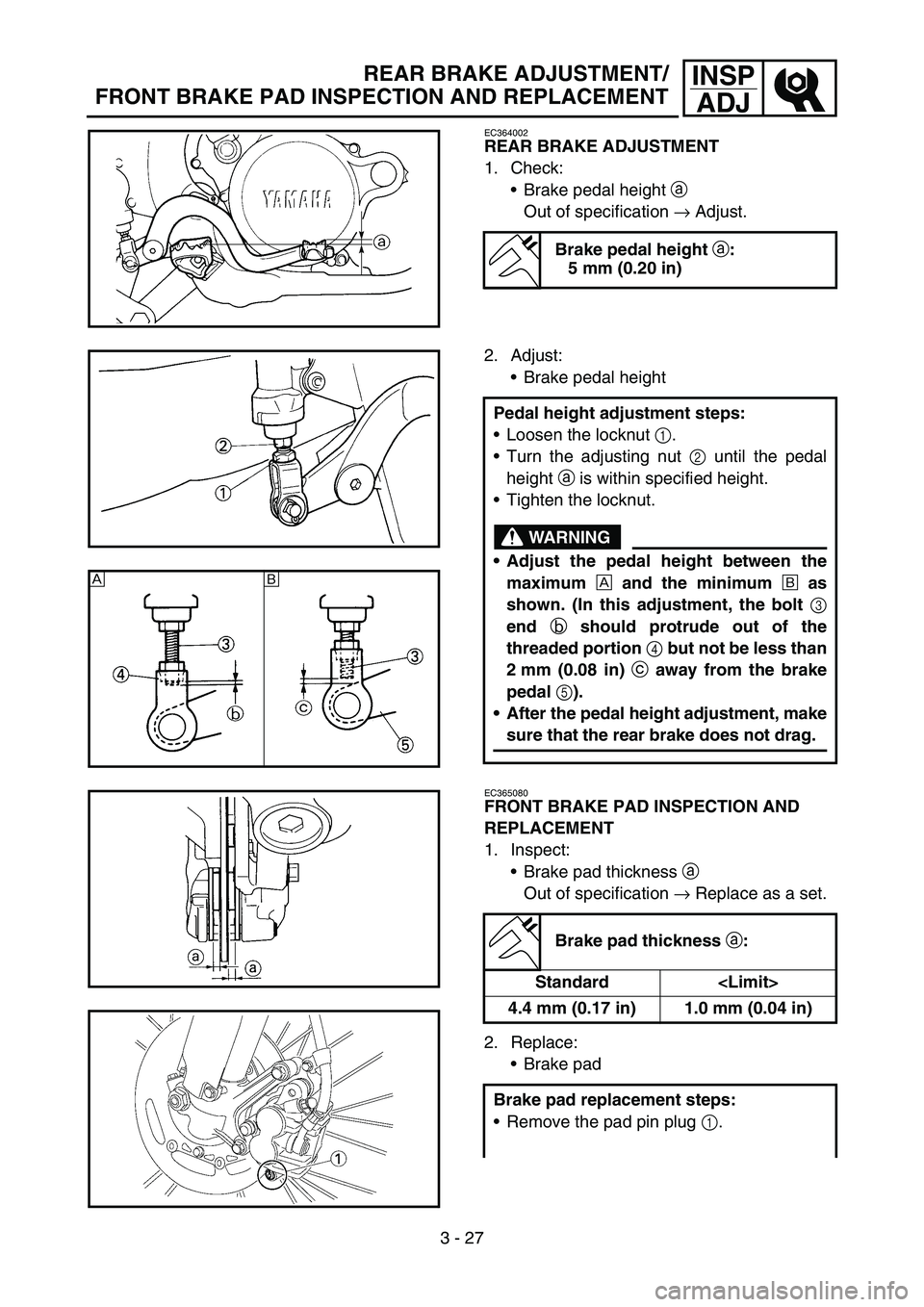
3 - 27
INSP
ADJREAR BRAKE ADJUSTMENT/
FRONT BRAKE PAD INSPECTION AND REPLACEMENT
EC364002
REAR BRAKE ADJUSTMENT
1. Check:
Brake pedal height a
Out of specification → Adjust.
Brake pedal height
a:
5 mm (0.20 in)
2. Adjust:
Brake pedal height
Pedal height adjustment steps:
Loosen the locknut 1.
Turn the adjusting nut 2 until the pedal
height a is within specified height.
Tighten the locknut.
WARNING
Adjust the pedal height between the
maximum
È and the minimum
É as
shown. (In this adjustment, the bolt
3
end
b should protrude out of the
threaded portion
4 but not be less than
2 mm (0.08 in)
c away from the brake
pedal
5).
After the pedal height adjustment, make
sure that the rear brake does not drag.
È
É
EC365080
FRONT BRAKE PAD INSPECTION AND
REPLACEMENT
1. Inspect:
Brake pad thickness a
Out of specification → Replace as a set.
2. Replace:
Brake pad
Brake pad thickness
a:
Standard
4.4 mm (0.17 in) 1.0 mm (0.04 in)
Brake pad replacement steps:
Remove the pad pin plug 1.
Page 258 of 786
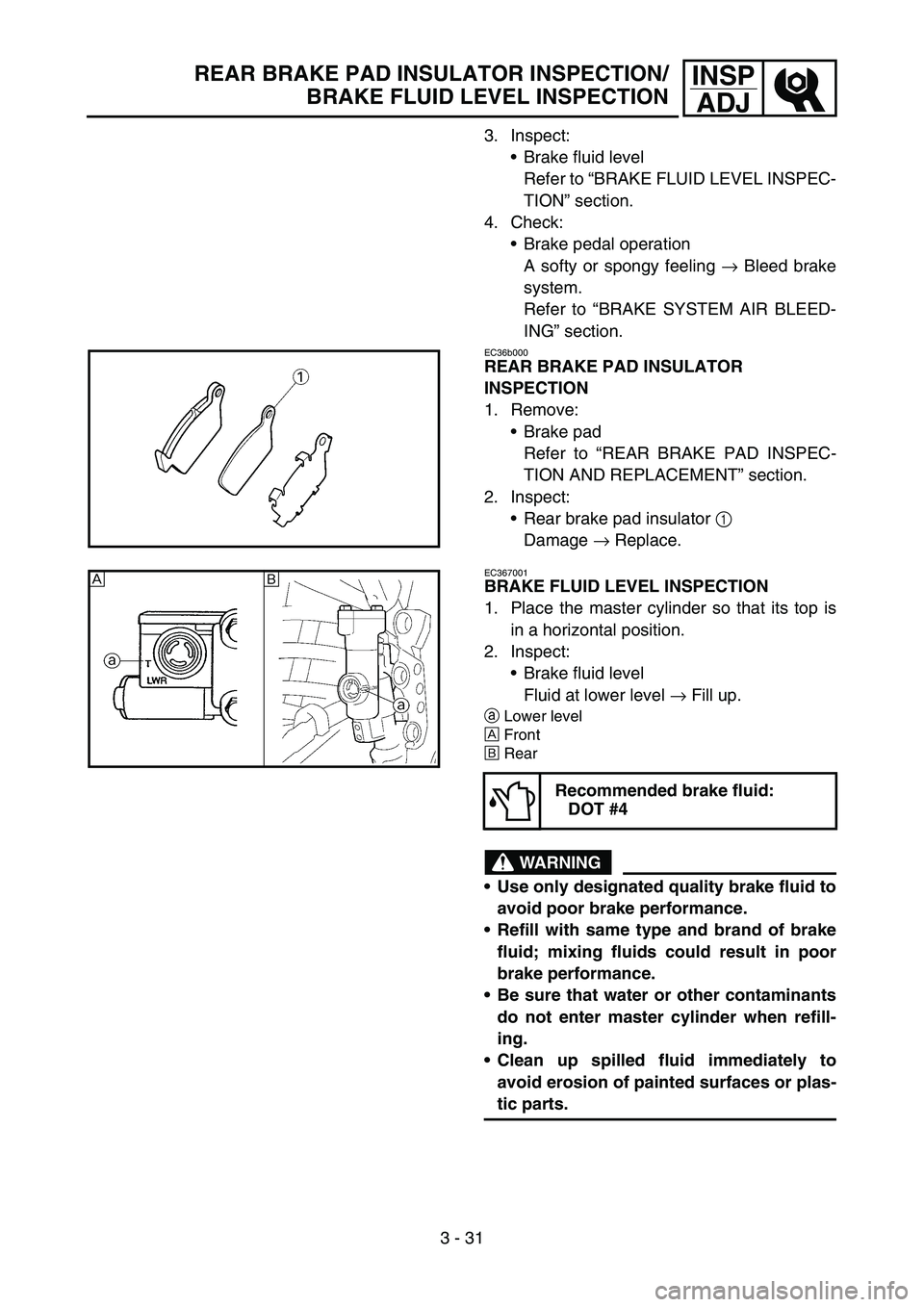
3 - 31
INSP
ADJREAR BRAKE PAD INSULATOR INSPECTION/
BRAKE FLUID LEVEL INSPECTION
3. Inspect:
Brake fluid level
Refer to “BRAKE FLUID LEVEL INSPEC-
TION” section.
4. Check:
Brake pedal operation
A softy or spongy feeling → Bleed brake
system.
Refer to “BRAKE SYSTEM AIR BLEED-
ING” section.
EC36b000
REAR BRAKE PAD INSULATOR
INSPECTION
1. Remove:
Brake pad
Refer to “REAR BRAKE PAD INSPEC-
TION AND REPLACEMENT” section.
2. Inspect:
Rear brake pad insulator 1
Damage → Replace.
EC367001
BRAKE FLUID LEVEL INSPECTION
1. Place the master cylinder so that its top is
in a horizontal position.
2. Inspect:
Brake fluid level
Fluid at lower level → Fill up.
aLower level
ÈFront
ÉRear
WARNING
Use only designated quality brake fluid to
avoid poor brake performance.
Refill with same type and brand of brake
fluid; mixing fluids could result in poor
brake performance.
Be sure that water or other contaminants
do not enter master cylinder when refill-
ing.
Clean up spilled fluid immediately to
avoid erosion of painted surfaces or plas-
tic parts.
Recommended brake fluid:
DOT #4
ÈÉ
Page 270 of 786
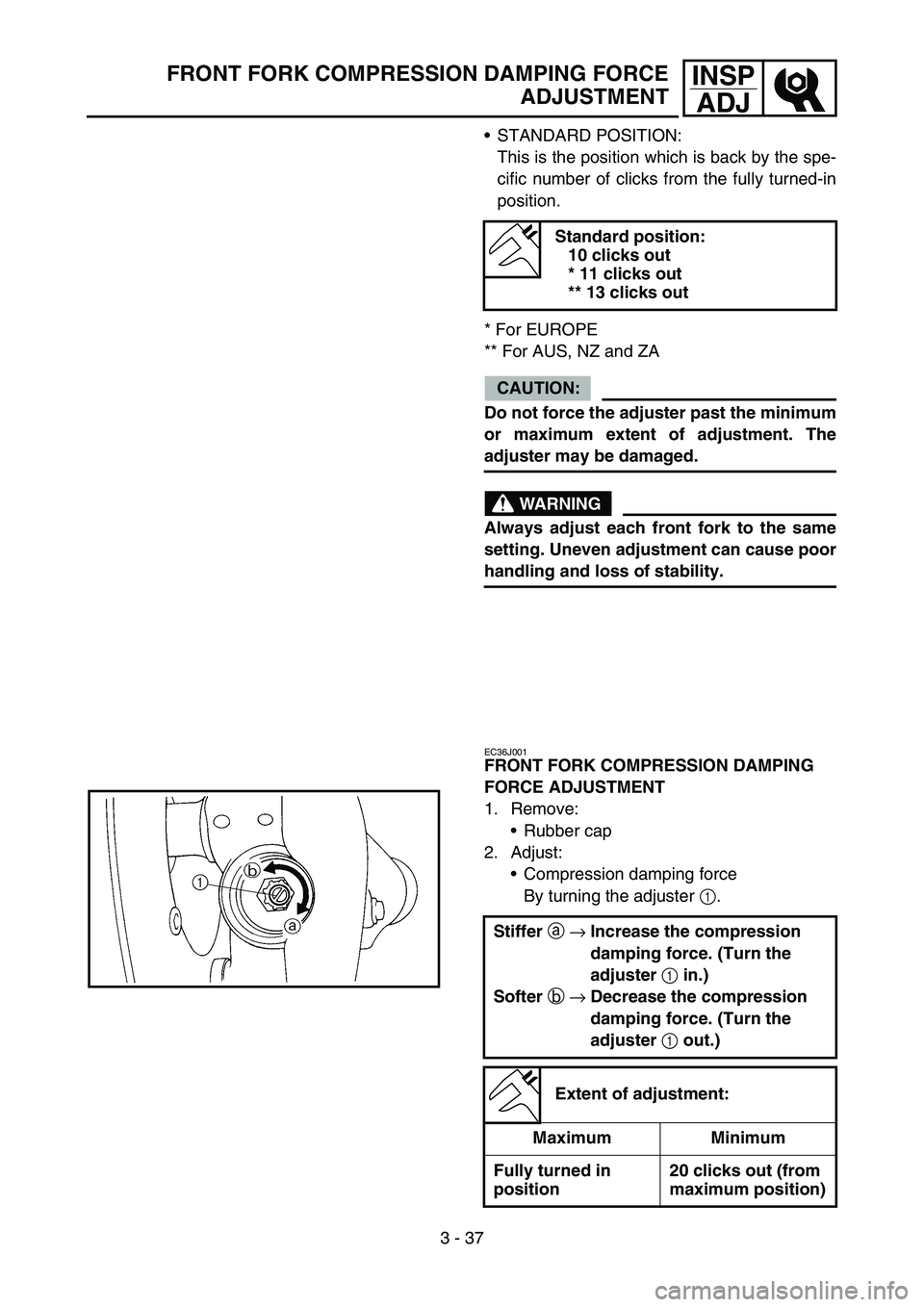
3 - 37
INSP
ADJFRONT FORK COMPRESSION DAMPING FORCE
ADJUSTMENT
STANDARD POSITION:
This is the position which is back by the spe-
cific number of clicks from the fully turned-in
position.
* For EUROPE
** For AUS, NZ and ZA
CAUTION:
Do not force the adjuster past the minimum
or maximum extent of adjustment. The
adjuster may be damaged.
WARNING
Always adjust each front fork to the same
setting. Uneven adjustment can cause poor
handling and loss of stability.
EC36J001
FRONT FORK COMPRESSION DAMPING
FORCE ADJUSTMENT
1. Remove:
Rubber cap
2. Adjust:
Compression damping force
By turning the adjuster 1.
Standard position:
10 clicks out
* 11 clicks out
** 13 clicks out
Stiffer
a
→Increase the compression
damping force. (Turn the
adjuster
1 in.)
Softer
b
→Decrease the compression
damping force. (Turn the
adjuster
1 out.)
Extent of adjustment:
Maximum Minimum
Fully turned in
position20 clicks out (from
maximum position)
Page 272 of 786
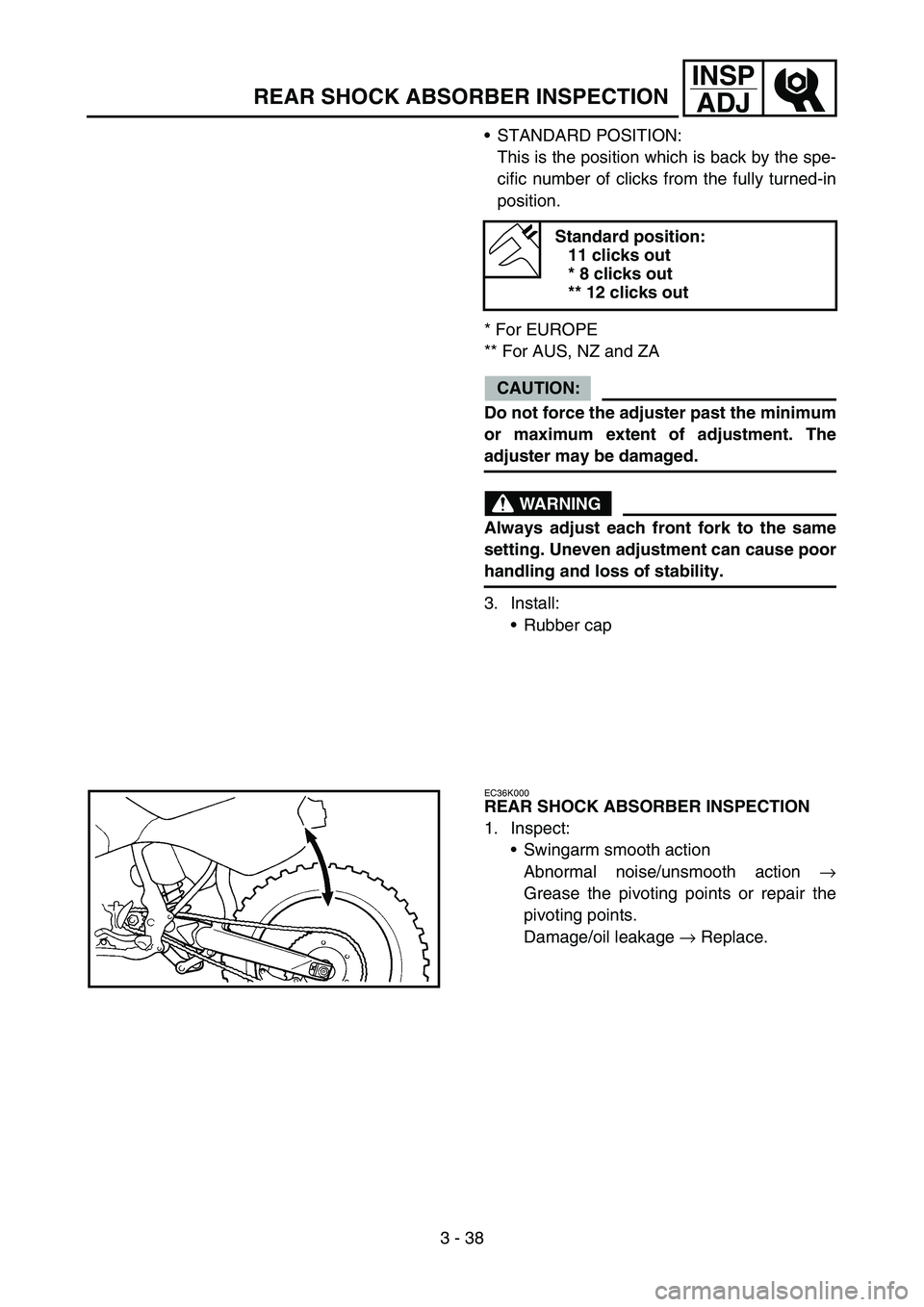
3 - 38
INSP
ADJ
REAR SHOCK ABSORBER INSPECTION
STANDARD POSITION:
This is the position which is back by the spe-
cific number of clicks from the fully turned-in
position.
* For EUROPE
** For AUS, NZ and ZA
CAUTION:
Do not force the adjuster past the minimum
or maximum extent of adjustment. The
adjuster may be damaged.
WARNING
Always adjust each front fork to the same
setting. Uneven adjustment can cause poor
handling and loss of stability.
3. Install:
Rubber cap
Standard position:
11 clicks out
* 8 clicks out
** 12 clicks out
EC36K000
REAR SHOCK ABSORBER INSPECTION
1. Inspect:
Swingarm smooth action
Abnormal noise/unsmooth action →
Grease the pivoting points or repair the
pivoting points.
Damage/oil leakage → Replace.
Page 286 of 786
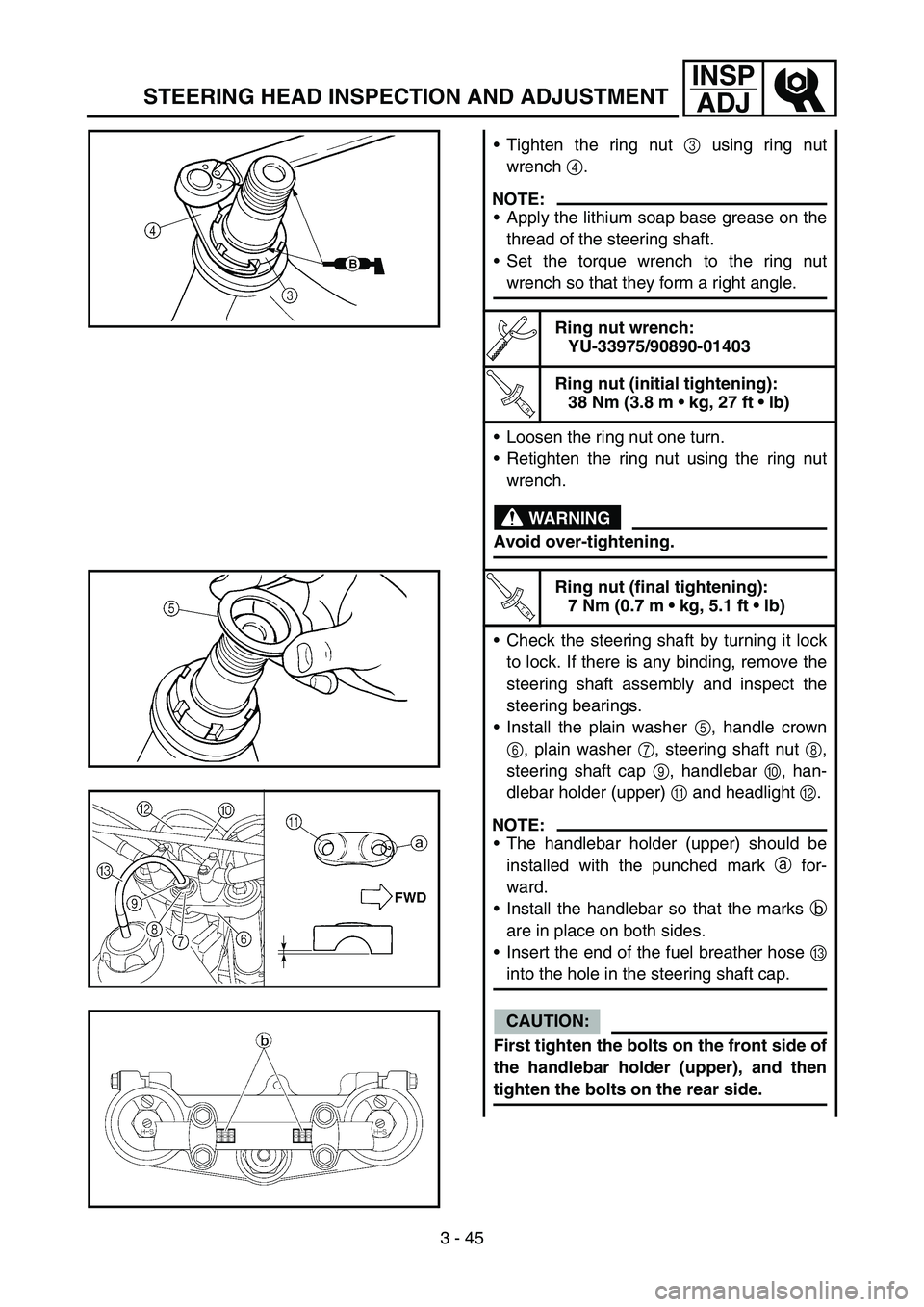
3 - 45
INSP
ADJ
STEERING HEAD INSPECTION AND ADJUSTMENT
Tighten the ring nut 3 using ring nut
wrench 4.
NOTE:
Apply the lithium soap base grease on the
thread of the steering shaft.
Set the torque wrench to the ring nut
wrench so that they form a right angle.
Ring nut wrench:
YU-33975/90890-01403
T R..
Ring nut (initial tightening):
38 Nm (3.8 m kg, 27 ft lb)
Loosen the ring nut one turn.
Retighten the ring nut using the ring nut
wrench.
WARNING
Avoid over-tightening.
T R..
Ring nut (final tightening):
7 Nm (0.7 m kg, 5.1 ft lb)
Check the steering shaft by turning it lock
to lock. If there is any binding, remove the
steering shaft assembly and inspect the
steering bearings.
Install the plain washer 5, handle crown
6, plain washer 7, steering shaft nut 8,
steering shaft cap 9, handlebar 0, han-
dlebar holder (upper) A and headlight B.
NOTE:
The handlebar holder (upper) should be
installed with the punched mark a for-
ward.
Install the handlebar so that the marks b
are in place on both sides.
Insert the end of the fuel breather hose C
into the hole in the steering shaft cap.
CAUTION:
First tighten the bolts on the front side of
the handlebar holder (upper), and then
tighten the bolts on the rear side.
Page 296 of 786
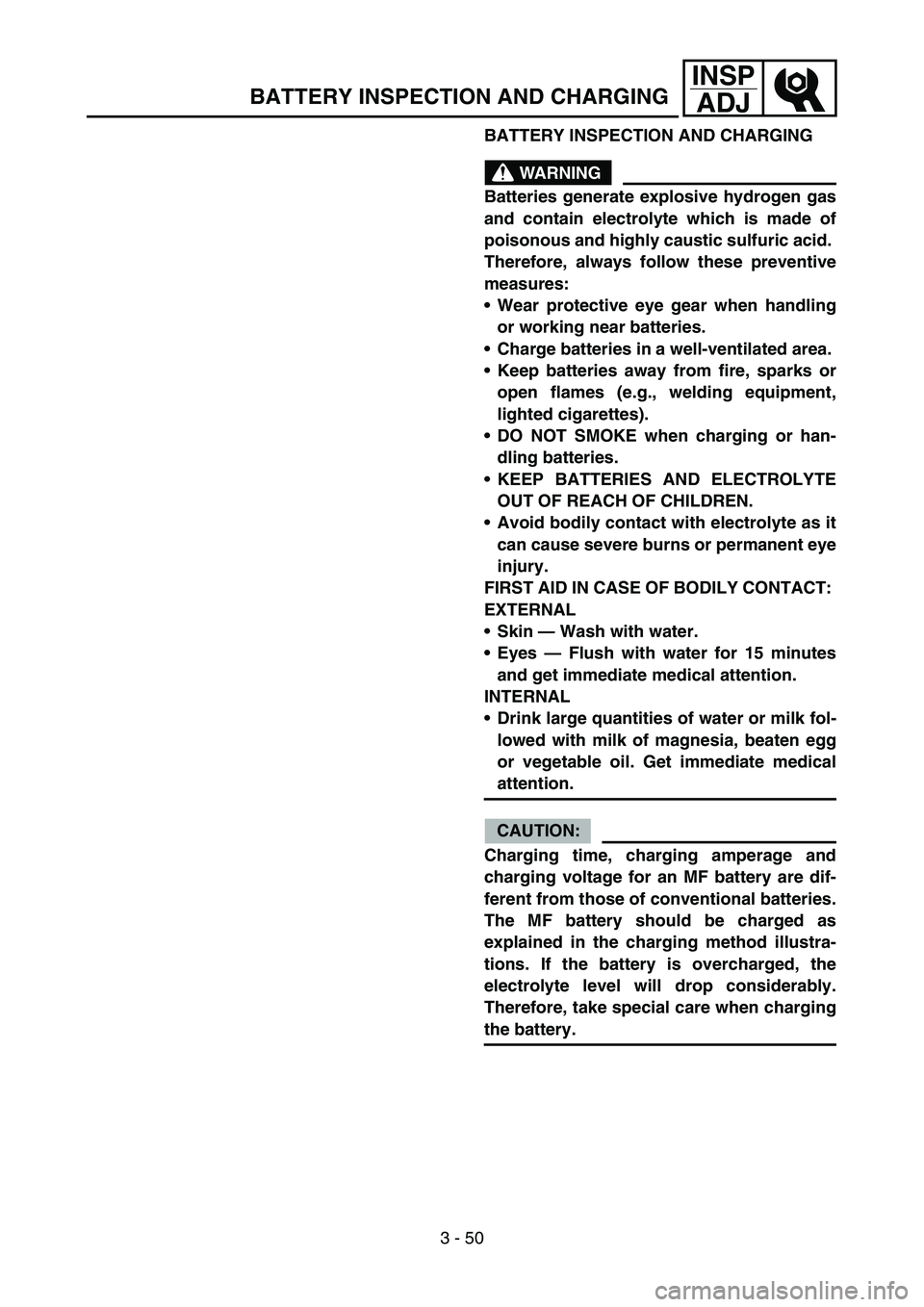
3 - 50
INSP
ADJ
BATTERY INSPECTION AND CHARGING
WARNING
Batteries generate explosive hydrogen gas
and contain electrolyte which is made of
poisonous and highly caustic sulfuric acid.
Therefore, always follow these preventive
measures:
Wear protective eye gear when handling
or working near batteries.
Charge batteries in a well-ventilated area.
Keep batteries away from fire, sparks or
open flames (e.g., welding equipment,
lighted cigarettes).
DO NOT SMOKE when charging or han-
dling batteries.
KEEP BATTERIES AND ELECTROLYTE
OUT OF REACH OF CHILDREN.
Avoid bodily contact with electrolyte as it
can cause severe burns or permanent eye
injury.
FIRST AID IN CASE OF BODILY CONTACT:
EXTERNAL
Skin — Wash with water.
Eyes — Flush with water for 15 minutes
and get immediate medical attention.
INTERNAL
Drink large quantities of water or milk fol-
lowed with milk of magnesia, beaten egg
or vegetable oil. Get immediate medical
attention.
CAUTION:
Charging time, charging amperage and
charging voltage for an MF battery are dif-
ferent from those of conventional batteries.
The MF battery should be charged as
explained in the charging method illustra-
tions. If the battery is overcharged, the
electrolyte level will drop considerably.
Therefore, take special care when charging
the battery.
BATTERY INSPECTION AND CHARGING